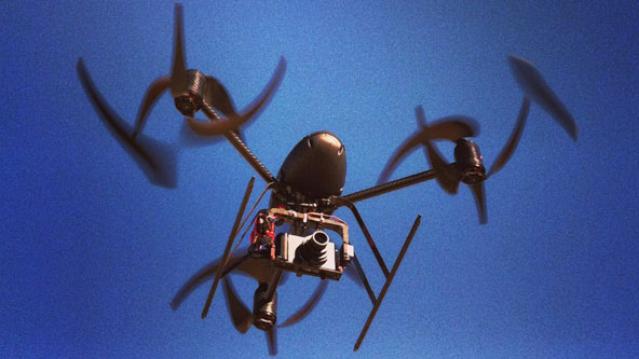North Dakota Police Can Now Legally Use Taser Drones

It’s a classic case of unintended consequences. A Republican lawmaker in North Dakota put forth legislation meant to prevent law enforcement officials from using unmanned aerial vehicles to conduct surveillance on private property without a warrant. It was transformed by fellow lawmakers into a bill allowing the police to mount Tasers, pepper spray, sound cannons and other “less-than-lethal” weapons on flying drones.
The legislation, House Bill 1328, was passed and signed into law earlier this year, but got little attention until this week, when a Daily Beast report pointed out the implications of the legislation: Law enforcement officers many miles away from suspects could have the authority to stun or otherwise incapacitate them.
Related: Ben Carson’s Idea for Controlling the Border – Military Drone Attacks
To be clear, the fact that something like this is technically legal doesn’t mean that state and local police departments will necessarily embrace the practice of remotely subduing suspects. Police officers are generally subject to local and departmental rules that can substantially limit what tactics are allowed.
The original version of the bill included language that would have barred law enforcement from mounting weapons of any kind on a drone: “A state agency may not authorize the use of, including granting a permit to use, an unmanned aircraft armed with any lethal or nonlethal weapons, including firearms, pepper spray, bean bag guns, mace, and sound-based weapons,” it said.
Supporters of the state’s police union introduced an amendment to the bill that would allow less-than-lethal weapons to be mounted on drones, according to the Daily Beast’s Justin Glawe. The amended bill was ultimately passed and signed into law.
Related: Europe Faces Up to Flight Safety Threat Posed by Drones
State Rep. Rick Becker this spring voiced his dismay at the changes to the bill in a public hearing, saying, “In my opinion there should be a nice, red line: Drones should not be weaponized. Period.”
Drones have, of course, been weaponized for years — the strikes just haven’t been in the U.S. If North Dakota is taking the lead, however, that might be about to change.
Top Reads from The Fiscal Times
- Trump Turns a Covetous Eye Toward Evangelical Voters
- Are Immigrants Really Taking American Jobs?
- Why the New Debt Ceiling Deadline Could Be Crucial
Chart of the Day: SALT in the GOP’s Wounds

The stark and growing divide between urban/suburban and rural districts was one big story in this year’s election results, with Democrats gaining seats in the House as a result of their success in suburban areas. The GOP tax law may have helped drive that trend, Yahoo Finance’s Brian Cheung notes.
The new tax law capped the amount of state and local tax deductions Americans can claim in their federal filings at $10,000. Congressional seats for nine of the top 25 districts where residents claim those SALT deductions were held by Republicans heading into Election Day. Six of the nine flipped to the Democrats in last week’s midterms.
Chart of the Day: Big Pharma's Big Profits
Ten companies, including nine pharmaceutical giants, accounted for half of the health care industry's $50 billion in worldwide profits in the third quarter of 2018, according to an analysis by Axios’s Bob Herman. Drug companies generated 23 percent of the industry’s $636 billion in revenue — and 63 percent of the total profits. “Americans spend a lot more money on hospital and physician care than prescription drugs, but pharmaceutical companies pocket a lot more than other parts of the industry,” Herman writes.
Chart of the Day: Infrastructure Spending Over 60 Years

Federal, state and local governments spent about $441 billion on infrastructure in 2017, with the money going toward highways, mass transit and rail, aviation, water transportation, water resources and water utilities. Measured as a percentage of GDP, total spending is a bit lower than it was 50 years ago. For more details, see this new report from the Congressional Budget Office.
Number of the Day: $3.3 Billion

The GOP tax cuts have provided a significant earnings boost for the big U.S. banks so far this year. Changes in the tax code “saved the nation’s six biggest banks $3.3 billion in the third quarter alone,” according to a Bloomberg report Thursday. The data is drawn from earnings reports from Bank of America, Citigroup, Goldman Sachs, JPMorgan Chase, Morgan Stanley and Wells Fargo.
Clarifying the Drop in Obamacare Premiums

We told you Thursday about the Trump administration’s announcement that average premiums for benchmark Obamacare plans will fall 1.5 percent next year, but analyst Charles Gaba says the story is a bit more complicated. According to Gaba’s calculations, average premiums for all individual health plans will rise next year by 3.1 percent.
The difference between the two figures is produced by two very different datasets. The Trump administration included only the second-lowest-cost Silver plans in 39 states in its analysis, while Gaba examined all individual plans sold in all 50 states.



